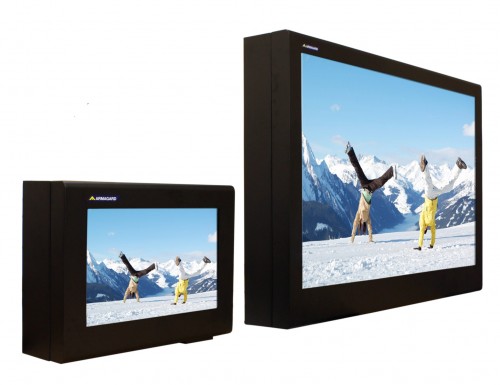Coping with Variable Temperatures with Outdoor Displays
Posted by: Richard Williams | Posted on: | 0 Comments
Outdoor displays are becoming increasingly utilised for all sorts of purposes: outdoor digital signage, wayfinding, or for providing information outside public buildings.
The rise in outdoor displays and in particular, outdoor digital signage is due, in part to the falling cost of these devices and the increasing prevalence of waterproof and outdoor devices – not to mention outdoor digital signage enclosures.
There seems no end to the types of different locations where outdoor screens can be placed and includes:
- High streets
- College campuses
- Ski resorts
- Gas stations
- Factories
- Roadside
When it comes to placing a screen outdoors, the weather elements are not the only environmental hazard that they have to be protected from – another consideration is the temperature.
In many locations, temperatures vary throughout the seasons and can go from one extreme to the other; baking hot sunshine in the summer, to freezing winters. And in some areas, these variations can happen daily; daytime temperatures can rise above forty degrees and then plummet below freezing in the winter.
This provides a distinct challenge for outdoor digital signage and any screen that has to cope in such an environment. Not only will high temperatures cause a display to overheat and fail but colder temperatures can cause condensation to freeze which can also disable a screen.
Temperature protection for outdoor digital signage can vary from location to location. Outdoor LCD enclosures often contain some/or all of the following components to combat extreme temperatures:
- Cooling fans – required even for low ambient temperatures as the screen can generate a lot of heat in itself. Cooling fans help to transfer the heat away from the screen preventing overheating.
- Insulation – for temperatures in colder climates when temperatures drop periodically o temporarily insulation can be used to retain heat and prevent the screen from freezing.
- Heaters – In areas where sub zero temperatures are commonplace heaters can be installed to increase the enclosed temperature above the lower limits. These are often thermostatically controlled and come on only when the temperature gets low enough.
- Automatic Cut off switches – In areas where extremely high temperatures are reached periodically and temporarily cur off switches can be used to automatically turn the screen off when the temperature gets too high and then switch it back on when the temperature drops to within operating range again.
Post shortlink:
Popular Products
LCD Enclosure
Need armor for your LCD/LED screen(s)? Outdoors or inside the versatile LCD enclosure protects against thieves, vandals & the weather. Installation idea: NFL stadiums.
Outdoor Digital Signage
Exclusive 46” outdoor screen protection. Dubbed the ‘Totem’, due to its distinct design, it repels damage threats, but attracts audiences. Installation idea: Drive-thru restaurants.
Portrait Flat Panel Enclosure
Safeguard your eye-level advertising display screen(s), indoors or outdoors. Completely customizable, add exciting features like touch screen technology. Installation idea: Restaurant frontages.
Indoor Digital Signage
Popular purchase for retail outlets! Great for ‘point of sale’ persuasion, boost your brand with static & motion advertising from a single unit! Installation idea: Mall of America.





